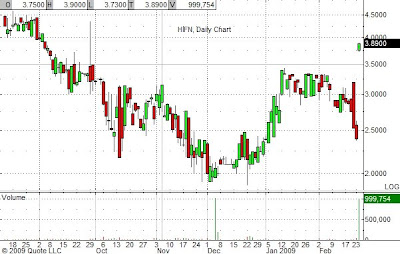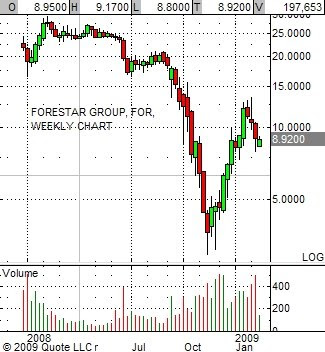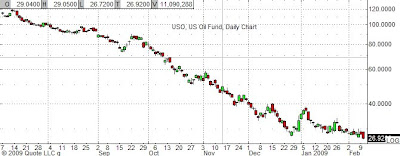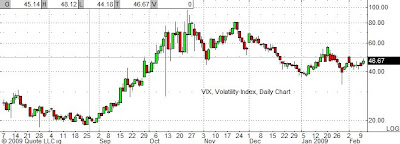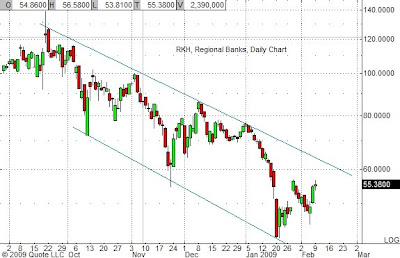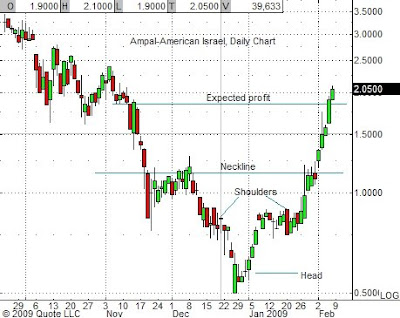Goldman-Sachs: Daily Chart
[Click on chart to enlarge.]

Here's a daily chart of Goldman-Sachs (GS). The stock began consolidating in March of last year, trading between $152 and $190-$200. On September 15th, the stock ended its consolidation pattern and gapped down through support, closing the day at $135.50 on heavier than normal volume. This was the day to enter a bearish position, either by shorting the stock or buying put options. It was also the day for you to either enter a sell-stop order or set an alert for your exit point.
Where is your exit? From yesterday, we saw that we can expect the stock to drop at least the same magnitude as the breadth of the consolidation ON A LOG SCALE and we gave formulas so that we can calculate it directly instead of measuring it on a chart. For Goldman, it's pretty clear where the bottom support level is—about $152, but the upper resistance level isn't quite as obvious. One technician might determine that $190 is the proper level thereby ignoring the data point at $200, while another technician might include it. You can choose which ever one you want, but I'd err on the conservative side and select the one at $190.
Using the $190 level, our exit point will be $122; using the $200 level, the exit point is at $116. You can see from the chart that the stock had no trouble sliding by either one. Exiting according to this plan would have netted at least $13 for an ROI (return on investment) of almost 10%. Not bad for two days!
But what would have been your return had you instead purchased a put? The only data I have at my fingertips is the price history of the 2009 April 135 put. On Sept. 15, it closed at a price of $21.40. Two days later, it closed at $36.20. That gives a profit of $14.80 per contract for a return of almost 70%--yowza! You can see why options can be so alluring and why they are used in come-on ads to inflate potential returns. What they don't tell you is that trading options is not a piece of cake--you really need to know what you're doing! (Please see my sidebar for options education info.)
Honeywell: Weekly Chart

Sometimes consolidation patterns that have long cycle periods (aka wavelengths to you tech-heads) aren't obvious on daily charts and you'll have to go to the weekly or even monthly charts to discern them. The chart of Honeywell (HON) above is one such example. A well-defined channeling pattern began in mid-2006. It enjoyed a successful two year run, bouncing between $52 and $62 (you could have made some money playing the channel—see recipe #3) before it finally broke down on 6/26/08. (You have to go to the daily chart to see this.)
Actually, it broke support the day before, closing under $52 for the first time in two years. The stock gapped down the next day which would have been your signal to enter a short position. If you had shorted near the open, you could have gotten in at $51. Your exit point for this trade would have been $43.60 (or you could have made it an even $44—this science isn't that exact). Several weeks later, the stock finally hit the $44 mark and had you exited then, you would have netted $7 for an ROI of almost 14%.
Had you instead bought the 2010 January 50 put on 6/26 at the closing price of $6.40, you could have sold it on 9/17 for $10.40. That's a gain of $4/contract for an ROI of over 60%!
Summary
You can see the power of channel breakouts, especially when the stock is moving in the same direction as the market. Of course, any monkey's uncle in recent months could have thrown a dart at the stock market and done well shorting virtually anything out there, but most of the time the market is not nearly this volatile. You should note this because in the case of the above two stocks, had you held at least a portion of your position past the exit point, you could have profited even further. This certainly would have been true had you shorted the stocks, but be aware that because of changes in implied volatility, your option positions may not have fared so well. Also be aware of the fact that the above options returns were based on the assumption that the options were liquid enough for me to buy and sell at those prices. In a real-life situation, that might not have been the case.
Later this weekend or Monday, I'll try to rustle up some stocks that are consolidating right now so that you can add them to your watch list.

